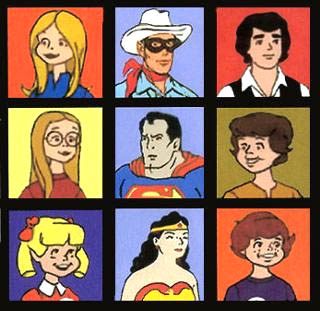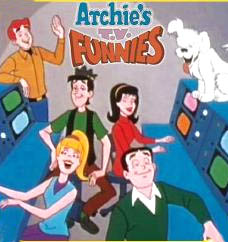 With all the warm and fuzzy nostalgia directed at the Brady Bunch over the last 30 years or so, those who were not around during the 70s might think that the Brady’s were considered the coolest thing going. Well, I’m here to say it wasn’t so. While I do admit to watching the Brady Bunch on Friday nights, I laughed at them more than with them. Even as a kid, I made fun of their Astroturf lawn, their lame clothes, and the bathroom without a toilet. When Greg got his groovy bachelor pad or pranced around as Johnny Bravo, I cringed and looked away. Yeah, I wasn’t fooled: they were a bunch of dorks.
With all the warm and fuzzy nostalgia directed at the Brady Bunch over the last 30 years or so, those who were not around during the 70s might think that the Brady’s were considered the coolest thing going. Well, I’m here to say it wasn’t so. While I do admit to watching the Brady Bunch on Friday nights, I laughed at them more than with them. Even as a kid, I made fun of their Astroturf lawn, their lame clothes, and the bathroom without a toilet. When Greg got his groovy bachelor pad or pranced around as Johnny Bravo, I cringed and looked away. Yeah, I wasn’t fooled: they were a bunch of dorks.Which makes it all the more difficult for me to figure out why I liked The Brady Kids cartoon show so much. Actually, it’s not if I put my mind to it. What made the cartoon work was that they put the kids in an environment all their own, much like Filmation was doing with The Archies (another show I really liked). No annoying parents or Alice, just the six kids, their mynah bird Marlon, the shaggy dog Mop Top, and their twin pandas
 In the early 70s, Filmation was branching out from their established niche of super hero and science fiction cartoons into more comedic directions. They started with The Archies. There were several variations on the Archies theme, but my favorite show was Archie’s TV Funnies, where they filled a half hour with small snippets featuring comic strip characters like Smokey Stover, Dick Tracy, The Captain and the Kids, Nancy, and others. Of course, I mainly watched for the Dick Tracy segments, which closely followed the style of the comic strip, unlike that other Dick Tracy cartoon incarnation.
In the early 70s, Filmation was branching out from their established niche of super hero and science fiction cartoons into more comedic directions. They started with The Archies. There were several variations on the Archies theme, but my favorite show was Archie’s TV Funnies, where they filled a half hour with small snippets featuring comic strip characters like Smokey Stover, Dick Tracy, The Captain and the Kids, Nancy, and others. Of course, I mainly watched for the Dick Tracy segments, which closely followed the style of the comic strip, unlike that other Dick Tracy cartoon incarnation.
The spin-off shows like Sabrina, the Teenage Witch and The Groovy Ghoulies were even more fun. I even liked their Jerry Lewis cartoon, Will the Real Jerry Lewis Please Sit Down! even though I was not a fan of Jerry Lewis. This leads me to one of those weird epiphanies that I still remember to this day. There was a sequence that was repeated in almost every episode where the animated Jerry would look into the camera and wiggle his ears and the laugh track would guffaw with hilarity. It was that same canned laughter that they would use in all the sit-coms of the day, which didn’t really sound like laughter at all but rather like bizarre cackles and kazoo noises. It made me think of evening in the arboreal forest of the planet Mongo. Anyway, one morning as I watched animated Jerry doing this very unfunny act and eliciting the joyous eruption of prerecorded chortles, I thought how ridiculous the whole canned laughter process was. I mean, it was hard enough to accept laughter echoing from nowhere while Colonel Hogan and Kinch were standing underneath a bridge in Nazi Germany with explosives, but from a cartoon? A series of drawings that were photographed one frame at a time to create the illusion of movement? Where could the audience be in that scenario? It was probably the first time I recognized the manipulative nature of the medium, and it aged me a little bit. But I digress…
In 1973, Filmation put out what I would consider their best animated effort: Star Trek: The Animated Series. Bringing back most of the actors and writers from the original series, the show was not merely a kiddie program, but for all intents and purposes the fourth season of what would become an iconic series. Moreover, the use of animation freed them from the tight budgets of the live-action show to create aliens and other worlds which could never have been achieved on the original series. Despite the limitations of the animation, Filmation produced unique alien vistas that I still find interesting today. At the time, I was not yet a Star Trek fan, primarily because every time I tried to watch Star Trek on my local station, they would be airing one of the Harry Mudd episodes. I hated Harry Mudd and thought that these comic relief episodes were a boring waste of time. Despite my lack of enthusiasm for Star Trek, I was curious enough to give the show a chance. The first episode of the cartoon series that I saw was…you guessed it…”Mudd’s Passion” with the master of cheese himself, Roger C. Carmel, providing the voice of the annoying Harry Mudd. I never watched another episode until it was in syndication years later.
Not that this put me off Filmation shows altogether. I still felt that they were far and away more inventive than any of the other producers of Saturday morning fare. One of my favorites was Uncle Croc’s Block starring Charles Nelson Reilly and Jonathan “Dr. Smith” Harris as the cranky Basil Bitterbottom. Reilly played the title character, a disgruntled kid show host with a cast of strange sidekicks. The show lampooned the kid shows that populated local TV stations across the country (in
In addition to the train wreck of a show Uncle Croc was conducting in the live-action world, there were regular cartoon features including Wacky and Packy, Fraidy Cat, Super Fiends, and M*U*S*H. M*U*S*H was my favorite since it was a parody of M*A*S*H, only this version had dogs. The title stood for Mangy Unwanted Shabby Heroes, a group of mounted dog policemen stationed at an outpost in the
Uncle Croc’s Block was like a less sophisticated version of Pee-Wee’s Playhouse, and its innovative style may have been ahead of its time, for the show was canceled mid-season. Its major competition was another Filmation show, The Shazam!/Isis Hour. With these shows, Filmation was entering a period where live-action would overtake its animation output. More on this era in a later post…



